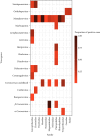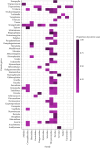Investigating Infectious Organisms of Public Health Concern Associated with Wild Meat
- PMID: 40303741
- PMCID: PMC12017266
- DOI: 10.1155/2023/5901974
Investigating Infectious Organisms of Public Health Concern Associated with Wild Meat
Abstract
The wild meat trade poses a significant threat to public health as it facilitates the spillover of zoonotic pathogens through high-risk activities such as the hunting, butchering, trade, and consumption of wild animals. Despite the health risks and association with marking epidemics including SARS, Ebola, and COVID-19, the global wild meat trade continues to thrive. To summarize the evidence available, primary literature published between 2000 and 2022 was systematically and critically assessed for evidence of zoonotic pathogens or other infectious organisms detected in samples directly from wild meat, from animals hunted for wild meat, or from humans exposed through high-risk activities. Within the 97 articles analyzed, a total of 114 pathogen genera (15 viruses, 40 bacteria, 54 parasites, and 5 fungi) were detected in wild meat animals belonging to 168 vertebrate species including mammals, reptiles and birds sampled in 32 countries. In the context of wild meat specifically, infectious organisms were differentiated between those with zoonotic potential (32% of reported genera), ectoparasitic vectors (1%), and possible opportunistic or environmental contaminants. Thirteen viral, four bacterial, and one parasitic genera were also documented in humans participating in wild meat trade activities, supporting pathogen spillover potential. Most studies employed a targeted approach to evaluate the presence of (i.e., polymerase chain reaction (PCR); n = 65) or exposure to (i.e., ELISA; n = 19) a specific pathogen, while only one study employed broad-spectrum metabarcoding techniques. The diversity of infectious organisms associated with wild meat are highlighted through this review and could be used to guide policy development. However, the common use of a selected set of targeted detection assays likely biases the exploration of pathogen diversity, therefore potentially preventing the discovery of "disease x". The global health risk demonstrated should make the illegal wild meat trade a priority for law-enforcement agencies and future research.
Copyright © 2023 Georgia Kate Moloney et al.
Conflict of interest statement
The authors declare that they have no conflicts of interest.
Figures







References
-
- World Health Organisation (WHO) World Health Organisation; 2022. Prioritizing diseases for research and development in emergency contexts. https://www.who.int/activities/prioritizing-diseases-for-research-and-de... .
-
- Okareh O. T., Morakinyo O. M. Monkeypox in Nigeria: a case report of re-emerged disease outbreak. Journal of Microbiology & Experimentation . 2018;6(2):89–91. doi: 10.15406/jmen.2018.06.00193. - DOI
Publication types
MeSH terms
LinkOut - more resources
Full Text Sources
Medical
Miscellaneous

